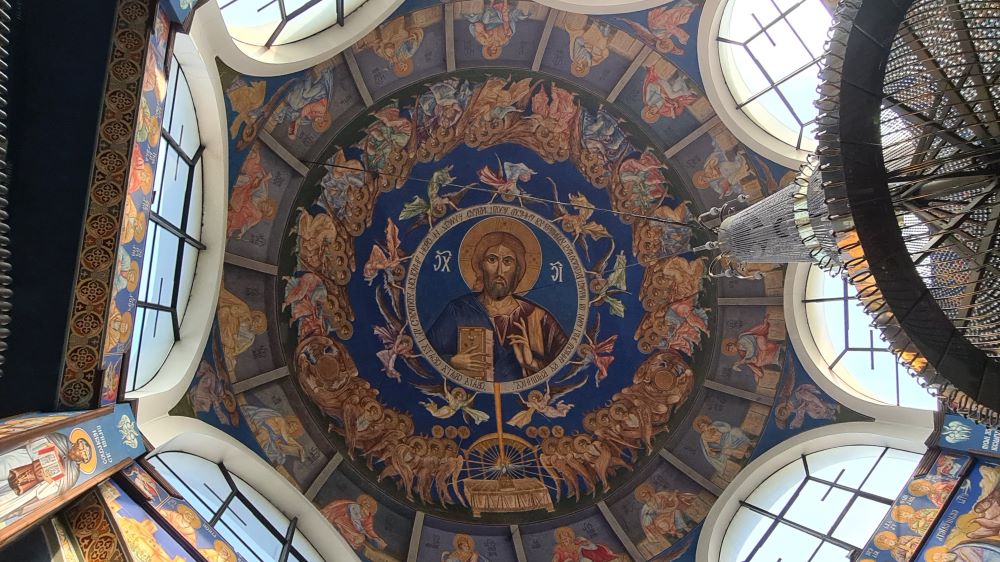A visit to the Church of St Clement of Ohrid

During my work visit to Skopje this summer I got struck by the beauty of this church. Nestled in the heart of North Macedonia lies a gem of cultural and religious significance—the Orthodox Church of Saint Clement of Ohrid. Revered for its historical importance, architectural splendor, and spiritual sanctity, this sacred site stands as a testament to centuries of tradition and religious devotion.
The church venerates Saint Clement of Ohrid, a distinguished scholar from Ohrid, renowned as an apostle to the Slavs. A devoted follower of the esteemed saints Cyril and Methodius, he held the honor of being the inaugural bishop of the Bulgarian Orthodox Church. Born between 830 and 840, and in 916 in Ohrid, which at that time formed part of the Bulgarian Empire.

Beyond its historical and religious significance, the church is a treasury of artistic brilliance, boasting an array of mesmerizing frescoes and intricate iconography that encapsulate the vibrant cultural heritage of the region.
A Canvas of Faith and History
The church’s interior is a living museum, where the walls and ceilings are adorned with vivid frescoes and icons, each narrating a story or conveying a profound religious message. The art within the church serves as a time capsule, offering a glimpse into the rich tapestry of Macedonian history, faith, and artistic expression.
Frescoes: Portraits of Spiritual Narratives
The frescoes adorning the walls are a marvel in themselves. The icons within the Church of Saint Clement of Ohrid are profound symbols of faith and devotion. These religious paintings depict saints, angels, and biblical scenes, offering a spiritual connection to worshippers and visitors alike. Each icon tells a sacred story, radiating a sense of reverence and piety.
The art of iconography holds a sacred place in Orthodox Christian tradition. These icons are not just decorations but are believed to be windows into the divine, carrying a spiritual significance that transcends their aesthetic beauty.

Some of the main themes depicted in these icons include:
Scenes from the Life of Christ
The life of Jesus Christ is a central theme in Orthodox iconography. Icons often portray events from Christ’s life, such as the Nativity, Baptism, Transfiguration, Crucifixion, Resurrection, and Ascension. Each scene carries symbolic and theological significance, illustrating key moments in the Christian narrative.

Icons of the Virgin Mary and Child
Icons featuring the Virgin Mary are prevalent. As featured in all iconostasis in Orthodox churches, the Theotokos is shown on the left side to the center of the bottom tier. These icons depict the sacred bond between mother and child and represent the veneration of Mary within Orthodox tradition. The Annunciation is separated in two frescos, the angel Gabriel on the left side behind the iconostasis and Mary on the right side (see photo of iconostasis above).


The Annunciation fresco in the church is split by the iconostasis. (source: photos taken by owner of blog)
Saints and Martyrs
Icons of various saints and martyrs hold a significant place in the church’s iconography. These icons honor the lives and sacrifices of revered saints, depicting them in poses that convey their piety, suffering, and spiritual authority. Each saint’s icon serves as a symbol of intercession and inspiration for the faithful.


The Last Judgment and Eschatological Themes
Some icons portray the Last Judgment, depicting the final reckoning of souls. These scenes often include imagery of heaven, hell, angels, demons, and the weighing of souls—a stark reminder of the consequences of one’s actions in the afterlife.

Feast Days and Liturgical Celebrations
Icons celebrating important feast days in the liturgical calendar of the Orthodox Church are also common. These icons depict events like Christmas, Easter, Pentecost, and other significant religious celebrations, commemorating key moments in Christian tradition.

Biblical Narratives and Parables
Various icons portray scenes from the Old and New Testaments, illustrating biblical narratives and parables. These visual representations help convey the teachings of the Bible and are intended to instruct and inspire the faithful.

Angels and Heavenly Beings
Icons featuring angels and celestial beings are prevalent, symbolizing the spiritual realm and the connection between the earthly and divine. Angels are depicted in various roles, serving as messengers, guardians, and guides in Orthodox belief.

Each theme depicted in these icons serves not only as a visual representation but also as a means of spiritual contemplation and devotion for worshippers. The iconography within the Church of Saint Clement of Ohrid offers a comprehensive and symbolic portrayal of Orthodox Christian theology, history, and spirituality.
The Church of St Clement of Ohrid is a beautiful place to visit in Skopje.